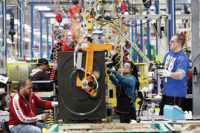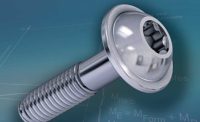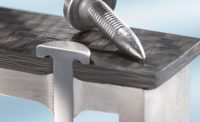As household appliance manufacturers continue using thinner sheets of material, engineers must address new challenges and explore alternative joining solutions.
For instance, thin sheet metal does not allow enough material to form enough thread for high clamp forces. Through and threaded holes often do not overlay correctly due to large part tolerances or inaccurate part positioning, resulting in increased and unknown drive-in torque.
“Consider the screw assembly task for refrigerator housings,” says Rudolf Schmidbauer, an application engineer at DEPRAG Inc. “Two pieces of sheet metal are to be screwed together, whose screw holes are not exactly aligned with each other.
“At first, it requires a lot of torque from the screwdriver in order to bring the sheet metal pieces into alignment with each other,” adds Schmidbauer. “The end phase of the screwdriving process, when the screw holes are aligned, requires a lower torque for the final screw tightening.
“Screw assembly with a constantly high torque, as in the initial phase of this application, would result in unintentionally reaching the destructive overload torque, and screws or the sheet metal may be distorted,” warns Schmidbauer.
Screws that are designed to form a thread during the screwdriving process are subject to a similar law. During the thread forming process, the screw joint requires a higher prevailing torque and, when the head of the screw begins to clamp the materials, another parameter setting is required.
“If this is not considered, the screwdriving task will fail, components or the screw [itself] will be destroyed, and the desired pretension will not be achieved,” says Schmidbauer.
“You either get the screw in with a high risk of stripping or the screw stops on its way due to the screwdriver switching off when the final torque value is reached,” adds Jan Aijkens, general manager of DEPRAG. “I’ve seen an assembly line at a large white goods manufacturer where literally every housing screw was stripped, resulting in a 100 percent scrap rate.”
For applications where the initial needed torque is higher than the final seating torque, DEPRAG engineers developed Sensomat. The handheld pneumatic screwdriver features a mechanical clutch function that’s especially well-suited for sheet metal assembly applications.
The screwdriver starts off using full motor power. However, shortly before the screw is seated, it releases the clutch and the screwdriver shuts off at the preset torque. The screw is fully installed without being stripped or damaged.
To avoid problems with incorrect torque rates and screw stripping, some manufacturers are also turning to an innovative alternative called flow form screwdriving (FFS). The high-strength fastening process forms a process-reliable joint for different types of sheet metal. Without the need for nuts, rivets, punching or predrilling, extremely short cycle times can be achieved.
“This technology is just beginning to find its way into the white goods industry,” says Lori Logan, marketing manager at DEPRAG. “Any place where sheet metal—or a combination of different types of alloys, such as steel and aluminum—needs to be fastened together, FFS is ideal.”
Flow form fastening only requires access to one side of the fastening point, which simplifies difficult assemblies. No punching or predrilling is required. Additional fastening components are not necessary, because the thread is formed directly inside the through-funnel.
With FFS, special screws—available from suppliers such as Arnold Umformtechnik and EJOT—are set in a six-step process:
*Heating. A slow form screw is positioned onto a metal sheet that has not been predrilled. The screw is applied with a high down-force and rotates at an extreme speed. It develops an intense level of frictional heat and the material begins to melt.
*Penetrating. The tip of the screw penetrates the material compound.
*Funnel forming. The screw tip penetrates further through the material, forming a funnel. At this point, the down-force, as well as the speed, is reduced.
*Thread forming. The screw continues to penetrate the material and the screw threads begin to contact the newly formed funnel, creating threads in the material.
*Screwdriving. The newly formed threads allow the screw to be driven through the material.
*Final tightening. The screw is tightened to the preconfigured torque and angle parameters.
“By using a 1:1 ratio offset gear to offset the drive motor and screwdriving axis to the side, the DEPRAG FFS screwdriving system can access screw positions located as little as 0.393 inches away from an obstacle,” claims Aijkens. “The screwdriving module can be turned in any direction and simplifies the deployment into any position. It is available with a single configuration with top-rear, left-right robot mounting capability.”




